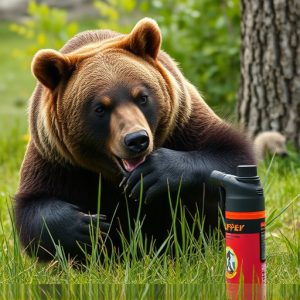Mastering Wilderness Survival: Wind Direction, Bear Spray Safety
Understanding bear senses and taking proactive safety measures, like being mindful of wind direction…….
Understanding bear senses and taking proactive safety measures, like being mindful of wind direction to optimize the use of bear spray, is crucial for preventing and escaping attacks in bear country. Training on proper spray usage, understanding its range (20-30 feet), and maintaining safe distances ensure effective deterrence while minimizing self-defence risks.
“In the vast wilderness, understanding bear behavior is key to ensuring your safety. This guide delves into the intricate world of bear attacks, focusing on how wind direction impacts bear spray safety—a vital defense mechanism.
Bears possess acute senses, and recognizing their behaviors can prevent dangerous encounters. We’ll explore the science behind these majestic creatures’ olfactory abilities and how they navigate their environment.
Furthermore, this article illuminates the strategic use of bear spray, considering wind direction as a critical factor in its effectiveness.”
- Understanding Bear Behavior and Their Senses: Key to Avoidance
- The Role of Wind Direction in Bear Spray Safety
- Effective Use and Considerations for Bear Spray as a Defense Mechanism
Understanding Bear Behavior and Their Senses: Key to Avoidance
Understanding bear behavior and their heightened senses is a crucial step in preventing and escaping potential attacks. Bears, especially grizzly bears, have an exceptional sense of smell, hearing, and vision, which they use to locate food and navigate their environment. Knowing this, it’s essential to practice certain safety measures when venturing into bear country. For instance, always be aware of the wind direction; if possible, travel upwind so that any scent you produce is carried away from you, making it less likely to attract a bear.
Bear spray is another critical tool for safety. Carried in hand, this pepper-based spray can create a barrier between you and an attacking bear by temporarily blinding and disorienting the animal. Proper usage involves keeping the spray bottle vertical and aiming for the bear’s face when it approaches within certain distance (often around 20-30 feet). Regular training and familiarizing yourself with this safety measure are key to ensuring its effectiveness in high-stress situations.
The Role of Wind Direction in Bear Spray Safety
Understanding wind direction is a critical component of bear spray safety. When carrying bear spray, it’s essential to consider how the wind might affect its effectiveness during an encounter. If you’re facing into the wind, the spray may blow back towards you, reducing its reach and potentially rendering it useless. Conversely, when the wind is behind you, the spray can travel further, increasing your protection range.
Knowing this dynamic allows hikers and campers to position themselves strategically in relation to the wind. During a potential bear encounter, moving slightly into the wind can help ensure that bear spray is deployed correctly, maximizing its impact as a deterrent while minimizing any risk of self-defence. This simple awareness of wind direction can significantly enhance safety measures during outdoor activities in bear country.
Effective Use and Considerations for Bear Spray as a Defense Mechanism
Bear spray is an effective defense mechanism for protecting yourself during a potential bear attack, but its use requires careful consideration and proper application. Understanding wind direction is crucial; spraying directly into the face of an attacking bear might not be enough if the wind blows the spray away from the bear. Ideally, aim for the eyes, nose, and mouth, as these areas are sensitive, and the irritant can cause the bear to retreat. Always follow safety guidelines by ensuring you have a clear escape route and are at a safe distance before deploying bear spray.
When carrying bear spray, keep it easily accessible, and be familiar with its range and effectiveness. Different types of bears may require specific techniques; black bears, for instance, tend to avoid conflict, so a quick burst of spray might deter them. In contrast, grizzly bears are more aggressive, and multiple bursts might be necessary. Regular training and knowing the appropriate response can significantly enhance your bear spray safety during outdoor adventures in wilderness areas.
Understanding bear behavior and utilizing the wind direction to your advantage are crucial components of wilderness survival. Bear spray, when used effectively, can be a powerful defense mechanism against unexpected attacks. By being aware of these key factors and practicing safe habits in bear country, you can significantly enhance your safety and enjoy a more secure outdoor experience. Remember, prevention and knowledge are the best tools to protect yourself from potential bear encounters.


